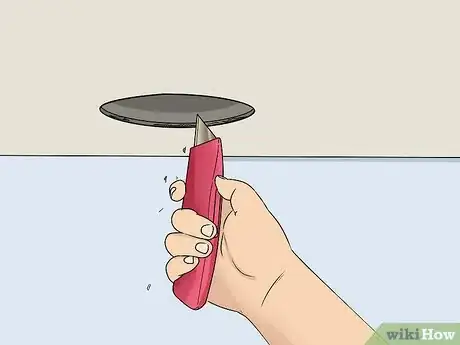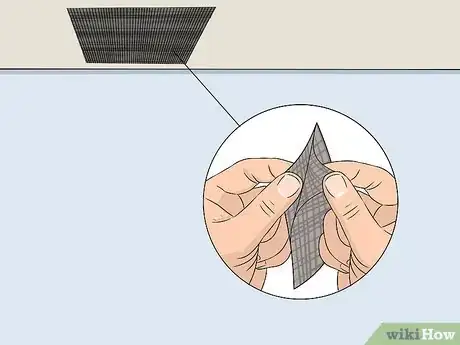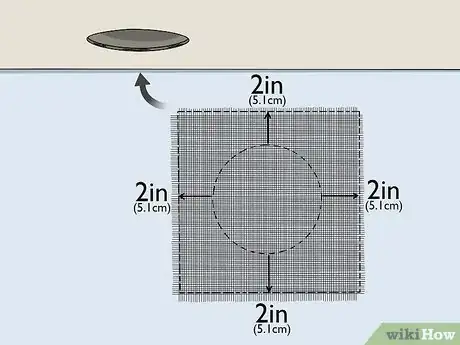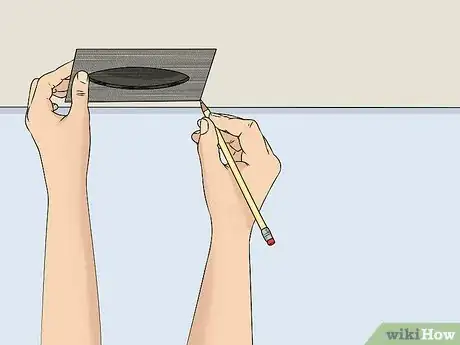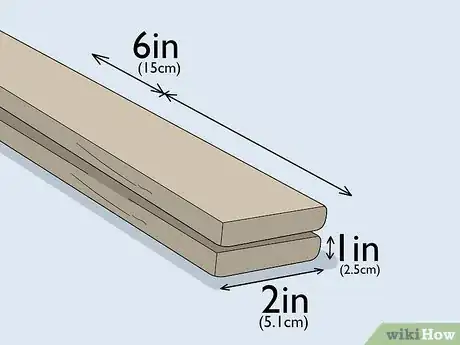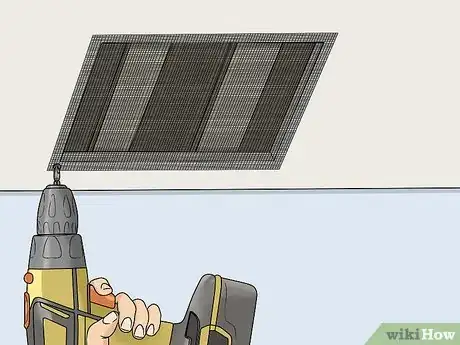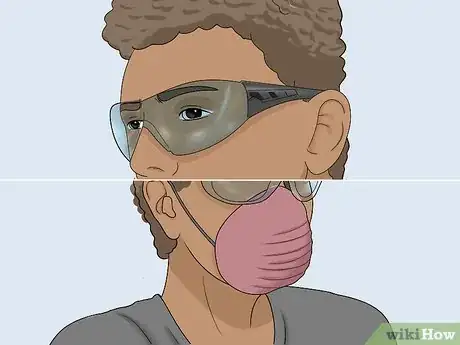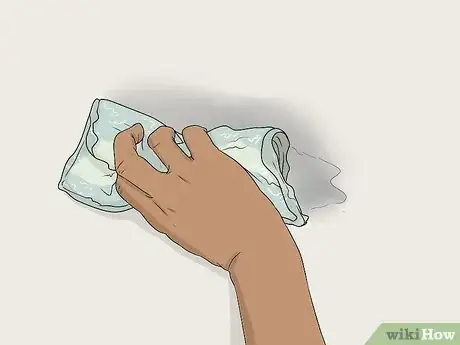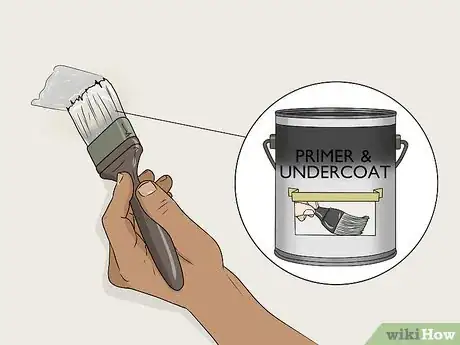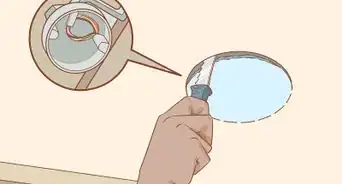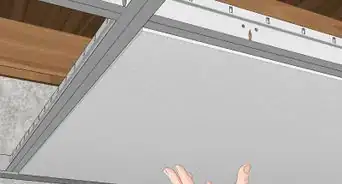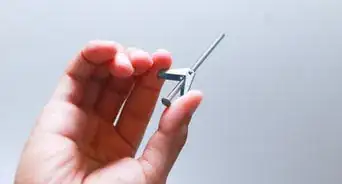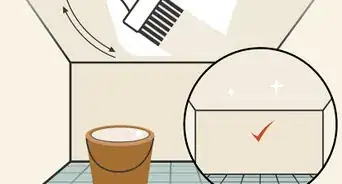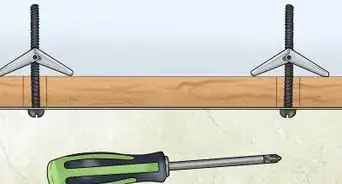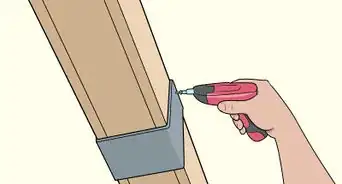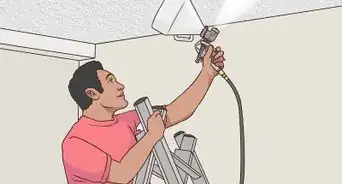This article was co-authored by Nick Yahoodain. Nick Yahoodain is a General Contractor and the CEO of Advanced Builders & Contractors in Los Angeles, California. With over 16 years of experience, Nick specializes in large residential projects such as new construction, developments, major renovations, additions, and hillside construction. Advanced Builders & Contractors is a member of the BBB, is licensed by the Contractors State License Board, and is fully bonded and insured. Advanced Builders & Contractors has been featured on NBC News, Elle Decor, Architectural Digest, and Voyage LA.
This article has been viewed 279,710 times.
Holes in the ceiling can be caused by many things, including leaks, lighting or fixture installation, and simple accidents. Patch small and medium-sized holes with a mesh drywall patch or make a square patch out of a new piece of drywall to fill in larger holes. Either way, cover the patch up with 2 coats of spackling, sanding after each coat, then prime the patch with a water-based primer before painting over it. Soon enough, you’ll have a hole-free ceiling again!
Steps
Patching Small and Medium Holes
-
1Put on safety goggles and a dust mask. You’ll be working underneath the hole, so it’s important to protect your eyes and mouth from falling drywall dust and debris. Safety goggles are better than safety glasses because they fully wrap around your eyes and don’t let anything in.[1]
- Drywall dust can cause respiratory problems if inhaled, so always wear a dust mask when cutting and repairing drywall.
- Make sure you have a sturdy step ladder to work with as well so you can reach the ceiling.
-
2Use a utility knife to cut away any loose debris around the edges of the hole. Carefully slice away any loose pieces of drywall and paper around the edges of the hole to neaten it up and get rid of any jagged edges. Try to clean the hole up enough that a drywall repair patch will be able to sit flush against the ceiling.[2]
- This method will work for holes in drywall ceilings that are up to 6 in (15 cm) in diameter.
Tip: For holes that are less than 0.5 in (1.3 cm) in diameter, you don’t need to use a patch. You can simply fill them in with a little bit of spackle.
Advertisement -
3Cut a drywall patch so it is 1 in (2.5 cm) bigger than the hole.[3] Cut a square drywall repair patch with sharp scissors so it is 1 in (2.5 cm) taller and 1 in (2.5 cm) wider than the hole you want to patch. This will give it 0.5 in (1.3 cm) of extra length and width on each side so it can adhere to the ceiling around the hole.[4]
- Drywall repair patches are made of a type of closely-woven mesh. They come in squares in different sizes up to about 8 in (20 cm) in diameter. You can buy a drywall repair patch at a home improvement center, hardware store, or online.
-
4Remove the backing from the patch and place the patch over the hole. Peel the protective backing off of the adhesive side of the drywall patch. Center the patch over the hole, then press it firmly against the ceiling around all the sides to make it adhere.[5]
- The adhesive will cure right away, so you can go ahead and start covering the patch with spackle.
- You now need to spackle and sand the patch to finish fixing the hole.
Patching Large Holes
-
1Protect your eyes and mouth with safety goggles and a dust mask. This will keep drywall dust and debris from the hole from getting in your eyes or mouth. Always wear this kind of protective gear when repairing holes in drywall and cutting drywall.[6]
- Safety goggles that fully wrap around your eyes are preferable to safety glasses that have open sides. You will be working right under a hole and debris and dust will be falling straight down, so more protection is better.
- You'll need a sturdy step ladder as well so you can stand on it to reach the ceiling.
-
2Cut a drywall square that is 2 in (5.1 cm) bigger than the hole.[7] Use a drywall saw or utility knife to cut a square patch out of a new piece of drywall. Make it 2 in (5.1 cm) wider and 2 in (5.1 cm) taller than the hole in the ceiling so you can cut the hole square to fit the patch.[8]
- You can get small pieces of drywall for making patches that are about 2 ft (0.61 m) by 2 ft (0.61 m). Purchase a piece at a home improvement center to cut the patch from if you don’t have any spare drywall lying around.
- This method works for holes that are bigger than 6 in (15 cm) in diameter.
-
3Trace the outline of the patch onto the ceiling around the hole. Center the square patch over the hole and hold it against the ceiling. Trace around the edges with a pencil to draw the outline of the patch on the ceiling so you can cut a square hole.[9]
- Get someone to help you hold the patch against the ceiling while you trace it if it is too big and awkward to do yourself.
-
4Use a drywall saw to cut the square outline around the hole out. Cut from the center of the hole diagonally out towards each corner of the outline you traced. Plunge the tip of the saw into a corner, then saw along the line at the side of the outline, removing the section of jagged drywall when you reach the other corner. Repeat this along each side of the outline until you have cut it all out.[10]
- You can test-fit the patch at this point to make sure it fits in the hole easily. If you need to make any adjustments, you can cut along the edges of the hole using a utility knife to remove small amounts of material.
-
5Cut 2 furring board strips 6 in (15 cm) longer than the width of the hole. Furring boards are 1 in (2.5 cm)-thick, 2 in (5.1 cm)-wide pieces of soft wood lumber used for various carpentry purposes. Cut 2 strips of furring board that are 6 in (15 cm) longer than the width of the square hole to be attached inside the hole and hold the patch in place.[11]
- You can buy furring strip board at a home improvement center or lumber supply shop. They usually come in 8 ft (2.4 m) sections, but you might be able to find smaller scrap pieces.
- You can use a hand saw or any kind of power saw you have available to cut the strips. Don’t worry too much about making the cuts perfectly straight as they will be hidden inside the ceiling.
-
6Attach the furring board strips inside the hole using drywall screws. Insert the strips at each side of the hole so the ceiling overlaps about 1/4 of the furring boards at the sides and the furring boards have 3 in (7.6 cm) of length against the inside of the ceiling at each end. Use an electric drill to insert a drywall screw through the ceiling and overlapping furring board at each end.[12]
- Make sure to hold the furring board strips firmly in place while you drive the screws through the ceiling into them to avoid leaving any gaps between the ceiling and the wood. If the furring board strips aren’t flush against the inside of the ceiling, the patch won’t sit flush with the ceiling.
-
7Screw the drywall patch to the furring board strips. Place the square drywall patch into the hole and hold it firmly against the furring board strips. Insert a drywall screw through the patch into the boards every 3–4 in (7.6–10.2 cm) or so.[13]
- Get someone to hold the patch firmly in place while you put the screws in if it’s too hard to do yourself.
- Note that you need to spackle and sand the patch to finish the job.
Spackling and Sanding
-
1Put on a dust mask and safety goggles. This is particularly important while sanding. The dust mask and goggles will ensure you don’t inhale dust from drywall or spackle or get it in your eyes.[14]
- Make sure you use goggles rather than regular safety glasses. Since you’ll be looking straight up at the ceiling while you sand, it’s better to have protection that wraps completely around your eyes.
- Use a sturdy step ladder to reach the ceiling while you are sanding and spackling.
-
2Use a putty knife to apply a thin layer of spackle over the patch. Scoop up some spackle on the edge of a putty knife. Drag it across the patch to cover it, overlapping the spackle onto the surrounding wall by about 2 in (5.1 cm). Scoop more spackle onto your putty knife as needed and keep applying it until you have covered the patch evenly.[15]
- Make sure you press spackle down into all the holes in a mesh drywall patch or into the seams between a drywall patch and the ceiling around it.
Tip: If you prefer, you can use joint compound, also known as drywall mud, instead of spackle. The advantage of spackle is that it dries faster and shrinks less, making it ideal for filling in and patching holes.
-
3Let the first coat of spackle dry overnight. Spackle is typically dry after 2-4 hours, but drying times vary depending on conditions. Leave the first coat to dry overnight to be sure it is completely cured before you proceed to sand it and add another coat.[16]
- If you don’t let the spackle dry completely before proceeding with the process, moisture can get trapped inside and cause the patch to fall apart over time.
-
4Sand the patch with 120-grit sandpaper to smooth it out. Put a piece of 120-grit sandpaper on a sanding block or just sand by hand. Sand the entire patch down lightly until it is evenly smooth. Sand very lightly around the edges where the patch overlaps with the surrounding ceiling to blend the spackle in with the rest of the ceiling.[17]
- Run your hand over the patch as you go to feel for any rough spots and then sand those areas further until the whole patch is smooth.
- Don’t sand too aggressively or you might end up removing the first layer of spackle, just try to make it uniformly smooth and blend it in with the texture of the ceiling.
-
5Wipe the patch with a dampened rag to remove dust. Wet a clean cloth and wring out the excess water. Wipe down the patch after sanding to get rid of any spackle dust.
- This will help the second coat of spackle adhere better.
- You could also use a tack cloth or microfiber cloth if you have one handy.
-
6Apply and sand a second coat of spackle using the same technique. Use your putty knife to spread another thin coat of spackle over the patch, dragging the knife across it to spread it out and blend the edges into the ceiling. Let it dry overnight, then sand it smooth with 120-grit sandpaper and wipe it down with a damp cloth.[18]
- If your ceiling is textured and you want to make the spackle match, you can dab it with a sponge while it is still wet and skip the sanding. You could also roll on a final coat of watered-down spackle with a textured paint roller.
-
7Prime the patch with a water-based primer.[19] Use a paintbrush or small paint roller to apply 1 coat of water-based primer to the patch to cover the spackle. Allow the primer to dry for 3 hours before proceeding to paint over it.[20]
- Most water-based primers will actually dry in 30 minutes to 1 hour, but let it dry for at least 3 just to make sure it is 100% dry before you paint over it.
-
8Paint over the patch to make it match the rest of the ceiling. Paint over the patch with paint that is the same color as the rest of the ceiling to make it blend in if you have some of the right paint color. Give the whole ceiling a new coat of paint if you don't have paint of the same color to use on the patch.[21]
- For example, if the ceiling is white, it would be fairly easy to just apply a white coat of paint to the patch and not repaint the whole ceiling. However, if the ceiling is a different color and you don't have any leftover paint that matches it lying around, you're probably better off repainting the whole thing.
Warnings
- Wear goggles and a dust mask to protect yourself from drywall dust and debris while fixing holes in a drywall ceiling.⧼thumbs_response⧽
- Be very careful whenever operating a saw.⧼thumbs_response⧽
- Use a sturdy step ladder to help you reach the ceiling.⧼thumbs_response⧽
Things You'll Need
Patching Small and Medium-Sized Holes
- Safety goggles
- Dust mask
- Utility knife
- Drywall patch
- Scissors
Making Drywall Patches for Large Holes
- Safety goggles
- Dust mask
- Utility knife
- Drywall saw
- Piece of drywall
- Drywall screws
- Furring board strips
- Saw
- Electric drill
- Pencil
Spackling and Sanding a Patch
- Safety goggles
- Dust mask
- Putty knife
- Spackle
- 120-grit sandpaper
- Sanding block
- Water-based primer
- Paintbrush or roller
References
- ↑ https://www.bobvila.com/articles/repairing-drywall/
- ↑ https://homesteady.com/how-15094-fix-holes-ceiling.html
- ↑ Nick Yahoodain. General Contractor. Expert Interview. 6 October 2020.
- ↑ https://www.businessinsider.com/how-to-repair-a-hole-in-drywall#how-to-patch-and-repair-larger-holes-in-drywall-6
- ↑ https://homesteady.com/how-15094-fix-holes-ceiling.html
- ↑ https://www.bobvila.com/articles/repairing-drywall/
- ↑ Nick Yahoodain. General Contractor. Expert Interview. 6 October 2020.
- ↑ https://www.do-it-yourself-help.com/how-to-repair-large-wall-ceiling-holes.html
- ↑ https://www.do-it-yourself-help.com/how-to-repair-large-wall-ceiling-holes.html
- ↑ https://www.diydoctor.org.uk/projects/repairceiling.htm
- ↑ https://www.do-it-yourself-help.com/how-to-repair-large-wall-ceiling-holes.html
- ↑ https://www.do-it-yourself-help.com/how-to-repair-large-wall-ceiling-holes.html
- ↑ https://www.do-it-yourself-help.com/how-to-repair-large-wall-ceiling-holes.html
- ↑ https://www.bobvila.com/articles/repairing-drywall/
- ↑ https://www.businessinsider.com/how-to-repair-a-hole-in-drywall#how-to-patch-and-repair-larger-holes-in-drywall-6
- ↑ https://homesteady.com/how-15094-fix-holes-ceiling.html
- ↑ https://homesteady.com/how-15094-fix-holes-ceiling.html
- ↑ https://homesteady.com/how-15094-fix-holes-ceiling.html
- ↑ Nick Yahoodain. General Contractor. Expert Interview. 6 October 2020.
- ↑ https://www.do-it-yourself-help.com/how-to-repair-large-wall-ceiling-holes.html
- ↑ https://www.do-it-yourself-help.com/how-to-repair-large-wall-ceiling-holes.html
About This Article
To fix a small to medium hole in a ceiling, first put on a dust mask and safety goggles. Cut away any rough edges and debris around the edge of the hole with a utility knife. Then, cut a piece of drywall patch so it’s about 1 inch (2.5 cm) bigger than the hole on all sides. Remove the adhesive backing and press the patch over the hole. Spread spackle over the patch in a thin, even layer with a putty knife. Extend the spackle about 1 inch (2.5 cm) beyond the edges of the patch. Let the spackle dry overnight before sanding it down with 120-grit sandpaper, then wipe the dust away with a damp rag. Repeat the process with a second coat of spackle. Apply a coat of water-based primer, let it dry for 3 hours, then paint over the patch. For more tips, including how to sand and paint your ceiling patch, read on!

